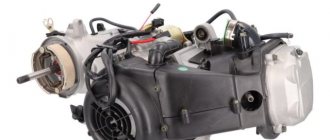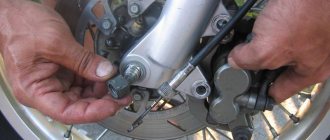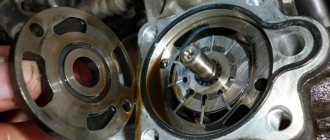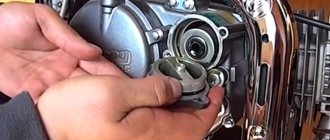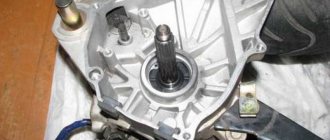Why do you need power steering?
Power steering is a system that is part of the steering system and is aimed at reducing the effort exerted by the driver on the steering wheel when changing direction.
At the same time, this system ensures that the driving conditions of the steered wheels are transmitted to the steering wheel, the so-called “road feeling”; this system also takes on shock loads from the wheels and absorbs them without transferring them to the steering wheel.
Advantages and disadvantages of the system
As a rule, complex equipment has both pros and cons. The ZIL-130 power steering was no exception. Advantages:
- softened shocks, impacts from wheels;
- reducing the number of steering turns required when turning;
- easier steering turn.
Flaws:
- High fuel consumption. Each additional element started from the engine will consume additional fuel.
- Reducing the power of the device due to the presence of a working pumping mechanism.
- Power steering cannot be controlled electronically (economy options).
Operating principle of hydraulic power steering
The hydraulic booster serves to assist the driver when turning the steering wheel. Consists of the following main elements:
- pump;
- expansion tank;
- highways;
- spool valve;
- two cylindrical cavities inside the rail.
To better understand why changing the oil in the power steering is a mandatory procedure, let’s briefly consider its operating principle.
Power steering operating principle
The pump takes liquid from the tank and pumps pressure into the line. When the steering wheel is turned, depending on which direction the force is applied, the spool valve directs a flow of liquid under pressure into one of the cylinders.
Due to the pressure on the piston inside the rack, additional force is created, which helps the rod move in the desired direction and reduces the necessary force that must be applied to the steering wheel.
Oil here plays not only a lubricating and protective function, but is also a carrier of energy. Therefore, the efficiency and durability of the entire system depends on its condition.
List of mechanism breakdowns
Breakdowns are a common occurrence for experienced drivers of such cars. Let us list the main ones that in one way or another will influence the condition of the ZIL-130 power steering:
- drive belt wear or weakening will require replacement of the structural element;
- the appearance of air flows in the system indicates the need to replace the fluid;
- pump failure requires repair or complete replacement of the component;
- An oil level below the required level will require refilling the tank with oil liquid.
Power steering device
Power steering is a closed, interconnected hydraulic system of components consisting of:
- Pump.
- Distribution device.
- Hydraulic cylinder.
- Backa.
- High and low pressure hoses.
Pump
The main part of the power steering design is the pump. With its help, pressure is created in the power steering and oil circulates in the system. It is fixed near the engine and driven by the crankshaft using a belt or gear drive (drive). The most common type of pump is a vane pump, usually a vane pump; it provides high wear resistance and high efficiency. However, it has a weak link, namely the bearing, which is why it has to be repaired. The pressure in this type of pump is about 150 bar, which is very high.
Distributor
The distributor in the power steering is a kind of regulator that directs oil from the reservoir to the hydraulic cylinder and back. It can be installed both on the steering gear shaft and on some parts of the steering mechanism. There are two types of distributor:
- axial - if the spool makes translational movements;
- rotary - if it makes rotational movements.
Hydraulic cylinder
Or as the power cylinder is also called, it performs the function of turning the wheels. The fluid in the power steering presses against the piston under pressure and forces the rod to extend, causing the wheels to turn. In order to push the rod back, the fluid from the reverse side presses on the piston and the wheels return to their original position. The hydraulic cylinder can be located both on the steering mechanism and between the steering gear and the vehicle body.
Tank
A reservoir for working fluid, which ensures the operation and lubrication of all connecting parts of the power steering. It contains a special filter to prevent dirt from entering, since the distributor is very sensitive to this. To check the oil level there is a special dipstick and marks on it. The tank is located under the hood, usually in a visible place next to the antifreeze tank and has a cylindrical shape.
High and low pressure hoses
Of course, all fluid circulation through the power steering system is provided by hoses, which are divided into:
- high pressure hose;
- low pressure hose.
High pressure power steering hoses circulate oil between the pump, rotary or axial distributor and hydraulic cylinder. And low pressure returns this oil from the distributor to the tank, as well as from the tank to the pump. It is important to monitor the condition of the hoses to avoid fluid leaks and damage to the entire mechanism.
How does a power steering pump work?
The operation of the power steering pump is based on the simple physical principle of increasing and decreasing volume and pressure difference. The rotor rotates inside an elliptical shaped stator. As the rotor rotates, the movable plates, under the influence of centrifugal force, move out of the grooves and rest against the walls of the stator, and then return to the grooves.
Interesting materials:
What is the name of the northern ridge of the Tien Shan Mountains? What is the name of the thing for playing records? What is the name of the thing that attaches to your phone case? What is the symbiosis of a fungus with the roots of higher plants called? What is the name of the fairy tale about the fox and the wolf, the beaten one brings the unbeaten one? What is the name of soldier's porridge? What is the name of the special program for viewing web pages? What is the name of the alloy of copper and nickel? What is the name of the alloy of gold, silver and copper? What is the middle lining of blood vessels called?
Where is the power steering reservoir located?
The power steering pump reservoir (also called the power steering reservoir) is an important part of the power steering system, which is a steering system that assists steering by applying hydraulic pressure to the steering mechanism. Most cars today have hydraulic power steering.
The power steering pump reservoir contains the hydraulic fluid that the power steering pump moves to help you steer. Without this fluid, the system will not function. Often the reservoir is directly connected to the power steering pump, which is located on the front of the engine near other engine accessories; however, the exact location of the pump will vary from one engine to another. Sometimes the power steering pump reservoir is installed remotely. In either case, there will be a pair of fluid lines to move fluid into and out of the pump. An example of the location of the tank is shown in the photo below:
Power steering
Hydraulic power steering
8.9 Clamp 10 Low pressure pipe on the expansion tank
Removal and installation
1. Remove the engine protective cover.
2. Remove the left air intake duct.
3. Pump out the oil from the expansion tank of the power steering pump.
4. Open the clamps (98) with a suitable tool.
Note
: When installing, use new clamps (8, 9).
5. Remove the low pressure line from the expansion tank (10).
6. Installation is carried out in reverse order.
7. Fill and bleed the power steering pump. For this:
(1) Raise the vehicle with a jack.
(2) Fill the expansion tank (1) with transmission oil to 10 mm below the maximum mark.
Attention
: Do not start the engine.
(3) Smoothly turn the steering wheel from one extreme position to the other about 30 times until the air bubbles disappear from the expansion tank.
(4) Start the engine without turning the steering wheel. At the same time, an assistant should measure the oil level in the expansion tank.
(5) Repeat procedure (3).
(7) Check the system for leaks with the engine running.
(8) Lower the vehicle.
8. Check the tightness of the hydraulic steering circuit with the engine running.
Checking and adjusting the oil level
1. Turn off the ignition.
2. Remove the spacer between the shock absorber strut cups.
3. Remove the engine protective cover.
4. Remove the locking cap (1) from the expansion tank (2) of the power steering circuit. To do this, push the locking cap (1) down and turn it 90° to the left.
5. Wipe the oil level dipstick (3) with a lint-free cloth and close the expansion tank (2) with the locking cap (1). Push the locking cap (1) down and turn it 90° to the right.
6. Remove the locking cap (1) again and check the oil level using the dipstick (3); adjust the oil level if necessary. The oil level at a temperature of about 20 °C should be between o (B) and “max” (A).
Note
: — To avoid errors when measuring, keep the oil level dipstick (3) vertical. — If the oil level is too low, identify the cause and eliminate it.
7. Close the expansion tank (2) with the locking cap (1).
8. Install the engine protective cover.
9. Install a spacer between the shock absorber strut cups.
Expansion tank
Removal and installation
1. Lift the front engine cover.
2. Remove the left air intake duct.
3. Pump out the oil from the expansion tank (1) of the power steering pump.
4. Loosen the clamp (3) of the return line on the expansion tank (1). Insert the plug into the return line and the hole in the power steering pump (1).
Note
: When installing, replace the clamp (3).
5. Remove the bolts (2) from the expansion tank (1).
6. Remove the clamp on the side of the expansion tank (1).
7. Pull the expansion tank (1) forward. Plug the holes.
8. Installation is carried out in reverse order.
9. Power steering pump: filling and bleeding.
What types of power steering fluids are there?
Based on the foregoing, it can be understood that all elements of the system only provide fluid pressure, give the desired direction to the parts and convert pressure into force. The main working element in the power steering system is liquid.
Power steering fluid, no matter who makes it, is based on petroleum components. Essentially this is the same oil, only with certain properties.
If motor oils have the main task of lubricating rubbing parts, then power steering oil has the task of transmitting force.
And since it must be quickly transmitted through the channels, the power steering fluid should not be very viscous, but at the same time this oil should also lubricate the system elements, but to a slightly lesser extent than engine oil.
Power steering fluids are available in two types:
- Mineral;
- Synthetic.
Mineral is used in most power steering, synthetic is less common.
A feature of these liquids is not interchangeability, as is the case with motor oils. In this case, switching from mineral fluid to synthetic fluid will lead to power steering failure.
And all because synthetic fluids contain additives that negatively affect the service life of rubber-based rubber elements, but there are enough such elements in power steering.
Ford synthetic power steering fluid “DP-PS”, 1 l.
Usually in those The vehicle documentation indicates that synthetic power steering fluid is used, and only that should be used.
If there is no information on the fluid in the documentation, then the car uses mineral by default.
Power steering oil requirements
- Heat resistance.
Since the oil is intended not only for lubricating mechanisms, it acts as a heat sink from heated parts and parts of the hydraulic booster. The liquid must be resistant to high temperatures up to 110⁰C, and also not lose its properties at low pressure and at temperatures down to minus 35⁰C.
- Stable viscosity.
Power steering oil contains additives that control the level of fluid viscosity under conditions of changing ambient temperatures. Thanks to this, at low temperatures the oil retains its properties and does not thicken, which allows you to rotate the steering wheel without extra effort.
- Transparency and homogeneity.
A distinctive property of good and high-quality oil is its transparent appearance and uniform consistency. Even after the machine has been idle for a long time, additives should not precipitate and clog the oil.
- Wear resistance.
Oil still has an aggressive effect on the rubber parts and mechanisms of the machine. It is worth choosing a type of fluid that has special additives with the function of a protective film, thereby reducing the wear life of rubber parts.
- Slight foaming.
An undesirable phenomenon in the power steering oil tank is foaming. The appearance of bubbles can have a bad effect on the steering wheel turning mechanism, namely, the process of transferring force from the steering wheel to the turning mechanism will be difficult. So you should pay attention to this important criterion when choosing oil.
Color characteristics of liquids
Also, power steering fluids are divided among themselves by color. Interestingly, initially they were all red - Dexron.
According to their class, power steering fluids are classified as automatic transmission fluids (ASF), but power steering fluids have a different designation PSF
.
At the same time, PSF is the same as ASF, but only the latter’s additives are slightly different, and are designed to work with gearbox clutches, which power steering does not have.
But these additives do not in any way affect the operation of the power steering, so Japanese cars often come from the factory with ASF poured into the power steering reservoir.
Why bleed your power steering system?
Perhaps the steering wheel has become noisy, or the steering wheel has become difficult to turn. These are potential signs of air getting into the power steering system.
Signs of trapped air in the steering system:
- You hear a whistling sound from the steering pump.
- Bubbles appear in the formation fluid.
- The reservoir fluid is low and foamy.
- The steering wheel is difficult to turn.
- The steering system is leaking.
- You hear a wheezing or growling sound at low speeds when turning.
- The steering wheel groans when it turns left or right.
- You hear a whirring noise when you turn the steering wheel.
- The steering system makes noise when operating.
Air can enter the system in different ways:
- due to damaged hose, fitting, seal or component
- after you have replaced some system component
- after you have disconnected and reconnected the hose
The following sections will help you check for trapped air and, if necessary, bleed the power steering system. You will find more than one method that you can apply, depending on your specific model.
Only add power steering fluid recommended by your vehicle manufacturer for your specific application.
- Checking the steering system for trapped air
You may not be sure if there is air in your steering system. Here are a couple of simple tests you can do at home to check your system for air.
Why is pumping needed?
As noted above, the power steering system is airtight . It must be free from moisture, air, dust or dirt, because only in this case can it fully perform its functions - apply the required pressure to the piston, lubricate the system’s spare parts and remove heat. Not only external factors have a detrimental effect on the operation of the hydraulic booster system.
The first hydraulic power steering was manufactured in 1925. Its creators were Francis Davis and George Jessop. The scientists installed the power steering on a Pierce-Arrow Roadster, owned by Davis.
Careless operation of the machine can cause a number of problems, resulting in:
- parts of parts wear out, which causes particles of steel chips to enter the liquid;
- rubber elements collapse and become unusable, as a result of which the seal is broken;
- the composition of the oil mixture changes under the influence of high temperatures;
- Hoses and pipes are destroyed.
All the factors described above lead to the fact that after a certain time the power steering system depressurizes.
This situation is very dangerous for vehicles, because:
- is capable of completely changing the operating technical properties of the drive;
- leads to the steering wheel being blocked in the right or left position, due to which it is not possible to control the vehicle;
- provokes uneven rotation of the steering wheel, which significantly complicates the precise execution of the maneuver.
Important! Pumping the power steering is a very serious and responsible undertaking, which guarantees the stable functioning of the steering. It is for this reason that it is extremely important to entrust the procedure to professional craftsmen.
To rid the system of air, they practice bleeding it, which allows you to restore the full functioning of the steering. At the same time, it is important not only to properly pump the power steering, but to maintain its performance for a long time.
To do this, experts advise:
- use only high-quality oils recommended by the manufacturer;
- remove air from the system, strictly following the instructions;
- replace the working mixture in full;
- monitor the condition of the steering rack boot and systematically clean the parts from dust.
Stay safe on the road
Air getting into the power steering system is not uncommon. But you want to clean up and, if necessary, fix any issues that led to the problem as soon as possible.
Trapped air in the steering system can cause:
- system noise
- uncertain steering
- damage to system components
Therefore, bleeding the system will not only remove trapped air from the lines, transmission and pump, but will also prevent costly repairs and a possible accident due to poor vehicle control.
Check, diagnose and, if necessary, correct steering system faults as soon as they appear.
Signs of malfunctions in the power steering system
There are several signs that the power steering system is airy, in which case it is necessary to bleed it. Among them:
- the appearance of strong noise in the area where the power steering or its pump is installed;
- increased pressure on the steering wheel , difficulty turning it;
- leakage of working fluid from the power steering system.
In addition, there are several other signs that indicate the system is becoming airy - the appearance of foam on the surface of the working fluid in the expansion tank, spontaneous turns of the steering wheel to one side. If you encounter at least one of the described symptoms, it means you need to bleed your power steering.
Other operational disturbances
Each failure case listed below will require separate disassembly to correct the violation in the ZIL-130 power steering:
- High-frequency noise (whistle) is heard. The belt drive mechanism may be loose.
- The occurrence of vibrations, steering wheel shocks. The working fluid does not meet the manufacturer’s technical specifications; there is a malfunction of the pump or mechanism that distributes the fluid.
- Lack of response and movement of the wheels to the steering control.
How to pump power steering
How to fill oil and bleed power steering
The procedure for replacing fluid and pumping power steering is carried out in strict accordance with the existing algorithm. Some automakers may add their own features to it. If you have a manual for your car, we recommend that you read the relevant section. In general terms, the steps must be performed in the following sequence:
- Raise the vehicle completely on a lift or with the front wheels off the ground.
- If necessary, drain the old fluid from the expansion tank. To do this, remove the return hose (going to the power steering system) from the expansion tank and put a plug on it so that liquid does not spill out of the hose. A hose leading to an empty bottle is connected to the released tap on the tank, where the old hydraulic fluid is supposed to be drained.
- It is most convenient to pump out the main volume of liquid with a syringe and pour it into a separate bottle. When there is very little liquid left, move on to the next point.
- Fill the expansion tank with working fluid to the top.
- Next, you should turn the steering wheel from side to side (from lock to lock) several times so that the old fluid remaining in the system flows out through the hose. Since the new fluid displaces the old, do not forget to monitor the oil level in the tank so that air does not get into the hose.
- If the fluid level drops, add it again.
- Start the engine for 2-3 seconds and turn it off. This is done so that the liquid begins to spread throughout the system.
It is important to remember that if you have aired the power steering system, the air can be expelled by bleeding it by rotating the steering wheel from side to side. However, do not start the engine under any circumstances, since the air in the system is critical for the power steering pump and can cause its failure.
Pumping out oil with a syringe
- Next, add working fluid to the tank to the MAX level and repeat the procedure by starting the engine. Repeat this cycle 3-5 times.
- The signal to stop pumping is the fact that air from the return hose stops entering the drain bottle. This means that there is no more air left in the hydraulic system and fresh, clean fluid enters the reservoir.
- After this, you need to reinstall the return hose (connect it to the expansion tank where it was originally installed).
- Refill the reservoir to the MAX level, then start the engine.
- To pump the hydraulic booster, you need to slowly turn the steering wheel 4-5 times from the left to the right stop. At the stop points, pause for 2-3 seconds. If there is any air left, it should escape into the expansion tank. During the inspection process, we make sure that the pump does not make any extraneous noise.
- An indicator that pumping has ended will be the absence of air bubbles on the surface of the liquid in the tank.
- After this, close the expansion tank tightly.
Bleeding the power steering system
can also be pumped without starting the engine , “cold”. To do this, just rotate the steering wheel from the left to the right stop . At the same time, old fluid and air leave the system. However, most automakers still recommend bleeding the system with the engine running.
The fluid level in the reservoir should be between the MIN and MAX marks . Remember that when heated, the liquid expands, so you should not pour it beyond the existing mark.
The need for an oil change
During operation of the hydraulic booster, the fluid decreases. Therefore, the necessary pressure is not provided, making driving difficult. In addition, the liquid may:
- the physical indicator changes at elevated temperatures;
- pollution occurs.
Therefore, the recommended replacement is made every 10-20 thousand kilometers or after 2-3 years.
A complete replacement will require 2-3 liters of oil, which expands when heated, so you need to leave some space free. To do this, 2 measurements are taken: hot, cold.
Reasons for air entry
In most cases, air enters the hydraulic system at the moment when car maintenance activities are carried out. For example, when replacing fluid in a hydraulic system. To avoid airiness, experts advise pouring the mixture at a rate of approximately 5.5–6 l/min.
If foam or bubbles form in the distribution tank during replacement, then you need to let the liquid sit for at least 20–30 minutes so that the air is completely released. Another common cause of air ingress is wear and tear of high-pressure pipes. To remove air from the power steering in such a situation, it is necessary to completely replace the unsuitable elements.
Typical power steering malfunctions
Malfunctions in the operation of the hydraulic booster can be easily identified by characteristic signs. Among them:
- The steering wheel turns hard . Probable causes are failure of the power steering pump, use of unsuitable working fluid, sticking of the spool mechanism channels.
- , a high-frequency sound (similar to a whistle) is heard while driving The probable cause is a loose drive belt.
- The steering wheel turns jerkily . Probable causes of the malfunction are the working fluid not meeting the specifications declared by the manufacturer, a malfunction of the fluid distributing mechanism, or a pump malfunction.
- The presence of intense foaming in the expansion tank. Probable causes are mixing of different types of fluids, failure of the power steering pump.
- When the engine is running, the steering wheel spontaneously turns in any direction . The probable cause is malfunction of the spool mechanism, most often, clogging of its working channels, incorrect assembly (for example, after installing a repair kit).
Signs of trouble
On the Internet you can find many different videos and materials that discuss the issue of airing and problems in the power steering on cars of different types, classes and sizes.
Therefore, do not be surprised if you come across questions regarding power steering pumping:
- on KAMAZ;
- on Shakman;
- ZIL 130;
- on the Volga (GAZ 31105);
- in Scania;
- Toyota Corolla;
- Nissan Qashqai;
- Lada Priora;
- Renault Symbol;
- Ford Focus;
- Niva Chevrolet;
- Volkswagen Passat B3;
- Toyota Avensis;
- Skoda Octavia;
- Renault Logan, etc.
The automotive power steering system can become airy for reasons already stated, related to breakdowns, or structural interference in the power steering.
At the same time, every driver is recommended to be aware of the characteristic signs indicating the fact that the system is air-filled. It is when they appear that mandatory pumping is required.
There is nothing difficult in diagnosing and detecting the problem. Look for the appearance of one or several signs indicated in the list:
- there is a strong noise near the power steering itself;
- strong extraneous noise may come from the power steering pump;
- there is a clear increase in pressure on the steering wheel;
- the steering wheel becomes harder to turn during maneuvers;
- leakage of working fluid is observed from the system;
- foam appears on the surface in the expansion tank with hydraulic fluid;
- The steering wheel rotates spontaneously in different directions.
Even one of the signs indicates that the unit needs to be pumped. If there is air in the power steering system, you will already know the signs. All that remains is to deal with the issue of self-pumping.
Is it worth pumping yourself?
The question is purely individual. It depends on your skills, capabilities and desire to save. The cost of the working fluid itself for power steering depends on many parameters, and therefore prices vary from 4 to 15 dollars per 1 liter. In total, pumping and replacement will require from 1 to 3 liters.
When you contact a car service center, they will charge you at least 1,000 rubles for pumping work. The replacement procedure costs about 2000 rubles. Now decide for yourself whether it’s worth spending money on this, or take everything into your own hands and solve the issue yourself.
Bleeding the power steering cannot be called difficult. Many inexperienced car owners easily perform this work. It is only important to follow the manufacturer's recommendations and use high-quality fluid suitable for your specific power steering.
Preparatory stage
If the following symptoms occur during operation of the power steering on a ZIL, begin the pumping process:
- The steering wheel mechanism experiences increased pressure and turns hard. It becomes difficult to make turning movements.
- Formation of non-standard noise interference. The pumping mechanism starts with a roar or such signs appear at the State Unitary Enterprise.
- Still usable fluid flows out of the hydraulics.
- Uncontrolled movements of the steering mechanism. Malfunction of the spool mechanism due to clogging of the existing channels or an error during assembly.
- Formation of foam composition inside the expansion tank (on top of the composition). In this case, it is possible that the products have been mixed or the pumping mechanism has malfunctioned.
If any of the listed signs appear, you should begin the procedure of pumping the power steering on the ZIL-130. It is from this origin that leads to the logical question of how to pump up the power steering on a ZIL-130.
Is it worth doing this work on your own? It depends on the desire, skills of the particular vehicle owner, as well as the need to save. The cost of the liquid is affected by parameters. For pumping you will need 1-3 liters.
Liquid leakage, where to look and how to fix it
Let's move directly to the technical part. So, the force on the steering wheel when driving has increased significantly. The most common cause of this phenomenon is the loss of fluid from the system.
There are not so many reasons for this phenomenon: damage or leakage of the system tank, possible weakening of the fastening of pipelines at the entrances to the components of the system, breakdown of the pipelines themselves.
These faults are easy to detect; just carefully inspect all pipelines and fastening elements for leaks.
If a leak is detected, it can be eliminated by tightening or replacing the damaged pipeline.
But that’s not the only place where a leak can form. It is much worse if the leak occurs due to worn rubber products included in the design of the pump or distributor.
It is more difficult to eliminate these leaks due to the need to remove the power steering units from the car and carry out repair work with the replacement of damaged elements.
Replacing power steering fluid
The fluid replacement process here is relatively simple and is similar in principle to many cars. You just need to make sure that air gets into the system, it disrupts its normal operation and can even damage the hydraulic pump.
Partial
During a partial replacement, only liquid is removed from the tank, after which it is filled with fresh fluid.
During operation, the remaining oil is mixed with the newly poured:
- the tank is opened, and the liquid present there is pumped out from there using a suitable syringe, onto which a flexible plastic or rubber tube is attached;
- the tank is filled with a new product to the maximum mark on its transparent wall or on the dipstick;
- the engine starts and the steering wheel is turned several times in both directions until it stops; it is better to carry out this operation with the front wheels hanging out;
- if necessary, the level is brought to normal;
- the operations can be repeated, the more liquid that takes part in the exchange, the purer the product remaining in the system will be.
With this method, it is very desirable to know what exactly was poured into the power steering and to prevent mixing fluids that have not been tested for compatibility.

